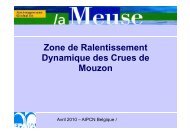PIANC E-Magazine - PIANC AIPCN welcome
PIANC E-Magazine - PIANC AIPCN welcome
PIANC E-Magazine - PIANC AIPCN welcome
Create successful ePaper yourself
Turn your PDF publications into a flip-book with our unique Google optimized e-Paper software.
Figure 3. Pressure schemes by the different authors<br />
concluded that the proposed distribution does<br />
not correctly simulate pressures in the area<br />
protected by the berm, overestimating the<br />
pressures on the base of the crown wall, so<br />
that the up-lift forces yield a very conservative<br />
value (see Figure 3a).<br />
8) Martín et al. (1995) proposed a formula to calculate<br />
the forces in the case of regular waves.<br />
The method is applicable to those crown walls<br />
of mound breakwaters that are not affected by<br />
impact pressures, i.e. those in which the waves<br />
are broken or running up on the slope.<br />
The proposed model is based on the appearance<br />
in the pressures laws of two out-of-phase<br />
peaks in time. The first peak is attributed to<br />
the horizontal deceleration of the water mass,<br />
while the second one is caused by the vertical<br />
acceleration when the accumulated water<br />
descends against the structure. Authors suggested<br />
two distributions for each pressure<br />
peak: for the first one they proposed an almost<br />
rectangular distribution, whereas for the second<br />
one they presented a nearly hydrostatic<br />
distribution (like those described by Günback<br />
and Göcke (1984), see figure 3b).<br />
For the up-lift pressures they proposed a triangular<br />
distribution according to the continuity<br />
of pressures; thus, the designed crown wall is<br />
on the safety side because it is supposed that<br />
wave impact occurs at the same time both on<br />
the vertical wall and on the crown wall base.<br />
9) Pedersen (1996) reached the following conclusions:<br />
• A linear dependency of the force with wave<br />
height exists if there is no overtopping. When<br />
overtopping begins, the force tends towards<br />
an asymptotic value.<br />
• The force is greater with longer wave periods,<br />
assuming that the force-wavelength relation<br />
is linear.<br />
• There is a clear linear dependency between<br />
the horizontal force and 1/Ac.<br />
• There is a clear linear dependency between<br />
the horizontal force and 1/cot .<br />
• The three types of armour units placed randomly<br />
(cubes, quarystone and Dolos) show<br />
almost identical values for the horizontal<br />
force.<br />
• When there is no overtopping, the crown<br />
wall height has no influence on the force.<br />
However, when overtopping exists, the observed<br />
forces are proportional to the square<br />
of the crown wall height.<br />
• The influence of the berm width is not evident.<br />
Pedersen’s (1996) model of pressures, like<br />
in the dynamic distribution by Günback and<br />
Göcke (1984) and Martín et al. (1995), offered<br />
two rectangular distributions: one for the zone<br />
not protected by the berm and the other for the<br />
protected zone (see figure 3c.). For the up-lift<br />
pressures, Pedersen (1996) proposed a triangular<br />
distribution that satisfies the pressure<br />
continuity.<br />
10) Silva R. et al. (1998) extended the Martín et al.<br />
(1995) method to irregular waves by the statistical<br />
characterisation of the run-up, which<br />
fits very well to the run-up values by Van der<br />
Meer (1988).<br />
11) Martín et al. (1999) introduced minor modifications<br />
to Martín et al. (1995), mainly in the<br />
run-up factor that directly affects the horizontal<br />
pressures and in the consideration of the<br />
up-lift pressures.<br />
For the up-lift pressures, they proposed a trapezial<br />
distribution if the foundations are below<br />
the sea level, including the hydrostatic pressure<br />
corresponding to the foundation level.<br />
<strong>PIANC</strong> E-<strong>Magazine</strong> n° 144, November/novembre 2011<br />
32




